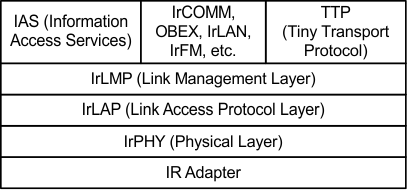SLAA202B February 2005 – December 2018 MSP430F149 , MSP430F149 , MSP430F2252-Q1 , MSP430F2252-Q1 , MSP430F2272-Q1 , MSP430F2272-Q1 , MSP430F2274 , MSP430F2274 , MSP430FG4619 , MSP430FG4619
-
Implementing IrDA With MSP430™ MCUs
- Trademarks
- 1 Introduction
- 2 Hardware Description
- 3 Software Description
- 4 PC Demonstration Application
- 5 IrDA Protocol Basics
- 6 IrDA Communication Diagram
- 7 Frame Exchange Log
- 8 References
- Revision History
5 IrDA Protocol Basics
Communication protocols are commonly divided into layers. These layers have their own responsibilities and dependencies to the layers above and below them, thus creating the concept of a protocol stack. Figure 15 shows the IrDA stack. This stack is built from the bottom up, with each layer dependant on the layers below. The first three layers shown are mandatory while those on top of IrLMP, except IAS, are optional protocols required only for specific applications. The required layers are:
- IrPHY: Specifies optical characteristics following ISO standards, data encoding/decoding, and framing for various speeds.
- IrLAP: Establishes the basic reliable connection, frame formatting, and parameter negotiation procedures.
- IrLMP: Multiplexes services and applications on the IrLAP connection level.
- IAS: Provides a database of services on a device.
Some of the optional layers are:
- TTP: Manages per-channel flow control.
- OBEX: Object exchange protocol, used to easily transfer files or other data objects.
- IrCOMM: Serial and parallel port emulation enabling devices that use these services to use IrDA interchangeably without problems.
 Figure 15. IrDA Stack
Figure 15. IrDA Stack